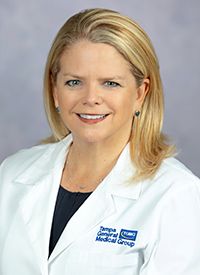Let’s Talk About Post-Mastectomy Chest Numbness
Just as advances in surgical techniques have made it possible to treat breast cancer and offer numerous options for breast reconstruction, there is also a surgical advancement to address a functional impairment often unintentionally caused by mastectomy: chest numbness.
Angela J. Keleher, MD, FACS

Just as advances in surgical techniques have made it possible to treat breast cancer and offer numerous options for breast reconstruction, there is also a surgical advancement to address a functional impairment often unintentionally caused by mastectomy: chest numbness.
Important to safety and quality of life (QOL), chest numbness is too often overlooked. However, many patients—whether they’re young or old, high-risk or in active diagnosis—want to talk about this adverse effect of mastectomies and what can be done about it.
Thanks to the supportive breast cancer community, people are learning about chest numbness and the possibilities of restoring sensation through others’ experiences. I’ve noticed a shift in my own practice, too—more patients are coming to me with questions, curious to learn more. I’ve found that discussing what’s important for survivorship and/or QOL post-surgery, such as the impacts of chest numbness and how breast neurotization can potentially restore sensation, naturally fits into conversations we’re already having about procedure options and associated risks and benefits.
Here are two ways you can incorporate chest sensation and breast neurotization into conversations you might already be having.
As You Ask Questions and Set Expectations With Your Patients
Seeking to understand what’s important to our patients and how we can adapt our treatment plans accordingly is a critical part of our jobs. The broader picture of their lives can also help us understand the importance of chest sensation to them, now and in the future.
A foundational question often asked is what the patient wants their life to be like post-surgery. It can help them start to think about—if they haven’t already—what their goals are after surgery. For many, it’s finding a sense of normalcy and reconnecting to themselves and their bodies.
However, those goals can be hard to achieve when they no longer feel a part of their body.
A natural time to talk about why numbness happens and possible breast neurotization outcomes is during conversations about surgery options and their associated risks.
Nerves allow us to interact with the world around us; they act like wires, carrying signals to and from the brain throughout the entire body. Motor nerves carry messages from the brain to muscles to make the body move. Sensory nerves send signals back to the brain, carrying the messages that allow us to feel touch, pain, pressure, and temperature. These nerves must be cut during a mastectomy so the breast tissue can be removed. If the nerves aren’t repaired during breast reconstruction, they can no longer send signals. No signal means no sensation, and the chest area may be left permanently numb.
Living with a numb chest can be a hard reality to grasp. Giving specific, illustrative examples can help patients picture themselves and what their lives could be like. For instance, many don’t consider how they might not be able to feel the temperature of water while swimming or showering. They might not know whether they’re getting sunburned or if their clothing is secure. They might feel disconnected from their body or like part of them has been deleted. From hugs to more intimate moments, maintaining a physical connection to a partner or loved one can start with the chest—a connection that can alter or be gone completely with numbness.
But when nerves are repaired during surgery using a nerve allograft, they have somewhere to direct their growth, potentially restoring a level of sensation over time (usually several months to up to 2 years).
As with most procedures, sensation outcomes vary from person to person. It’ll take time, because nerves grow around 1 millimeter per day, and sensation won’t be exactly as it was before surgery. Connecting patients with others who have gone through the procedure provides a firsthand opportunity to learn about their experiences.
As You Partnered With Others on the Care Team
When it comes to nerve preservation and breast neurotization, communication and collaboration are essential—especially between the breast surgeon and the plastic reconstructive surgeon. I’ve found the greatest success is when my plastic surgeon counterpart and I work closely together, from planning discussions to post-surgery follow-ups.
Before stepping into the operating room (OR) and starting a procedure, the breast and plastic surgeons should discuss the details of the patient’s case, as well as which nerves will likely need to be cut, becoming candidates for allograft nerve repair, and which may have the potential for preservation. That way, they have a shared vision when they get into the OR.
Consider a case in which a bilateral mastectomy with immediate reconstruction is possible. The breast surgeon performs the first mastectomy. As they move onto the contralateral breast, the plastic surgeon begins the reconstruction and nerve grafting. Both surgeons are in the same room, able to discuss what they’re seeing and doing to inform each other in real-time.
Taking a communicative and collaborative approach, from the first consult to the final follow-up, means we’re sharing information about the patient and, when helpful, talking with them together. The patient can tell the difference—they feel more taken care of.
As You Continue Changing Patients’ Lives
Our patients now have the potential to live their lives without a constant reminder of what they’ve been through. We have advanced techniques for mastectomies and reconstruction, and by learning more about breast neurotization and talking with patients about it, we can mitigate what was once considered an unavoidable AE of mastectomy.



